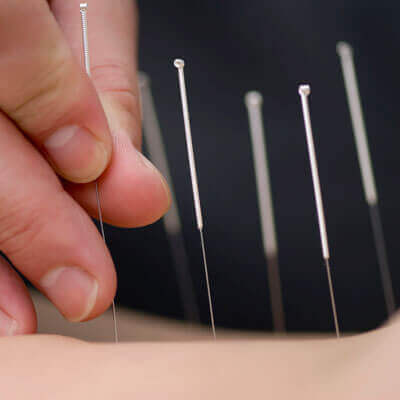By Dr. Irina Chan, Naturopathic Doctor
 If you’ve been living with pain, an injury, or ongoing muscle tension, you probably know that healing isn’t always a straightforward path. It can take time to figure out what treatments really makes a difference for your body. Acupuncture is one option that many people find helpful. It can reduce pain, support a quicker recovery, and improve how your body moves and feels. It is also a valuable addition to other hands-on treatments like chiropractic care and massage.
If you’ve been living with pain, an injury, or ongoing muscle tension, you probably know that healing isn’t always a straightforward path. It can take time to figure out what treatments really makes a difference for your body. Acupuncture is one option that many people find helpful. It can reduce pain, support a quicker recovery, and improve how your body moves and feels. It is also a valuable addition to other hands-on treatments like chiropractic care and massage.
What Is Acupuncture?
Acupuncture is a treatment that involves gently inserting very thin, sterile needles into specific points on the body to encourage healing and restore balance. These points are part of a system used in Traditional Chinese Medicine, where the body is seen as a network of energy pathways called “meridians.” Each meridian corresponds to different organ systems and bodily functions. By stimulating these points, acupuncture can help improve circulation, calm the nervous system, and support the healthy functioning of organs, helping the body return to a more balanced and resilient state.
Even if you’re not familiar with the traditional principles of acupuncture, modern scientific research increasingly supports how it works on a physiological level and its effectiveness in treating musculoskeletal conditions such as osteoarthritis, lower back pain, and tendonitis.
Research shows that acupuncture stimulates the release of endorphins, which are natural chemicals that help reduce pain. It also works by calming the body’s inflammation response, helping to lessen swelling and pain. Additionally, acupuncture activates specific nerve fibers that influence how pain signals travel through the spinal cord and brain, helping to “reset” abnormal nerve activity often seen in chronic pain conditions.
How Acupuncture Helps with Pain
Pain, whether it’s from a recent injury or something more long-standing, is often a result of inflammation, restricted circulation, muscle tension, or nerve dysfunction. Acupuncture helps target these underlying issues by:
- Reduces inflammation by encouraging the body to release natural anti-inflammatory substances like cytokines and endorphins
- Improves circulation by increasing blood flow to injured areas, delivering oxygen and nutrients needed for healing
- Modulates the nervous system by influencing how pain signals are processed in the brain and spinal cord, helping to reset abnormal nerve activity and calm the stress response
- Relieves muscle tension by relaxing tight muscles and easing trigger points
Acupuncture for Sports Injuries and Recovery
If you’re physically active or training competitively, you know how frustrating it can be to be sidelined by injury. The most common sports-related issues I see in practice include:
- Tendonitis (e.g., Achilles tendonitis, patellar tendonitis)
- Muscle strains or tears
- Ligament injuries (e.g., ACL, MCL)
- Rotator cuff injuries
- Shin splints
- IT band syndrome
- Plantar fasciitis
- Bursitis (shoulder, elbow, hip, knees)
- Ankle sprains
- Knee pain (e.g., runner’s knee)
- Hip flexor or groin strains
- Low back pain
- Elbow pain (e.g., tennis elbow, golfer’s elbow)
- Concussion syndrome
Acupuncture can be especially helpful once the initial swelling has gone down but healing is still in progress. It supports tissue repair, helps reduce pain without relying heavily on medication, and improves range of motion. By activating the body’s natural healing responses, acupuncture can promote a quicker recovery and a smoother return to training.
Complementing Massage and Chiropractic Care
Massage is excellent for releasing muscle tension and improving circulation, especially in larger muscle groups. While chiropractic adjustments help restore joint mobility and spinal alignment. For deeper or persistent pain, acupuncture can provide additional support by:
- Reaching deeper muscular trigger points and connective tissues
- Stimulates nerve function and repair in conditions like sciatica, peripheral neuropathy, trigeminal neuralgia, Bell’s palsy, and conditions involving pinched or compressed nerves.
- Enhancing blood flow at a deeper level, supporting tissue repair and recovery
- Further enhancing the release of natural pain-relieving endorphins and reducing inflammation
Acupuncture and other physical therapies can work together to effectively support a wide range of musculoskeletal conditions. When combined, these approaches complement each other by addressing different aspects of healing. This synergy often leads to more comprehensive and lasting results, especially when managing chronic or complex conditions.
A Whole-Person Approach to Healing
Acupuncture isn’t just about putting needles where it’s tender or sore. It’s about understanding the bigger picture.
As a naturopathic doctor, I consider your lifestyle, nutrition, stress, sleep, and overall health when creating a treatment plan. For example, someone with chronic low back pain often has more going on than just their back. They may also experience pain in the neck, hips, or knees, digestive issues, poor sleep, or high stress. These factors are often connected and can contribute to ongoing pain and slower healing. Acupuncture helps regulate multiple systems at once, which is why it often improves more than one issue at a time.
This whole-person approach is what makes acupuncture such a versatile and effective therapy. Pain is rarely caused by just one thing, so real healing often means going beyond the surface and addressing multiple contributing factors.
Frequently Asked Questions (FAQ’s) About Acupuncture
Let’s Talk Acupuncture
If you’re wondering whether acupuncture might be a good fit for you, Dr. Irina Chan would be happy to discuss how it can support your healing. To get started, give us a call or book your appointment online at https://www.healingpower.ca/contact-us/
CONTACT US
